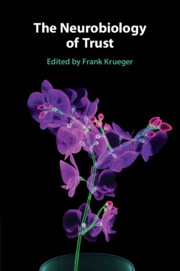Book contents
- The Neurobiology of Trust
- The Neurobiology of Trust
- Copyright page
- Dedication
- Contents
- Figures
- Tables
- Contributors
- Abbreviations
- Introduction
- Part I Fundamental Level of Trust
- Part II Neuropsychological Level of Trust
- Part III Neurocharacteristic Level of Trust
- Part IV Neuromolecular Level of Trust
- Part V Neuropathological Level of Trust
- Chapter 16 Trust and Psychotic Disorders
- Chapter 17 Trust and Personality Disorders
- Chapter 18 Trust and Lesion Evidence
- Index
- References
Chapter 18 - Trust and Lesion Evidence
Lessons from Neuropsychology on the Neuroanatomical Correlates of Trust
from Part V - Neuropathological Level of Trust
Published online by Cambridge University Press: 09 December 2021
- The Neurobiology of Trust
- The Neurobiology of Trust
- Copyright page
- Dedication
- Contents
- Figures
- Tables
- Contributors
- Abbreviations
- Introduction
- Part I Fundamental Level of Trust
- Part II Neuropsychological Level of Trust
- Part III Neurocharacteristic Level of Trust
- Part IV Neuromolecular Level of Trust
- Part V Neuropathological Level of Trust
- Chapter 16 Trust and Psychotic Disorders
- Chapter 17 Trust and Personality Disorders
- Chapter 18 Trust and Lesion Evidence
- Index
- References
Summary
Understanding when to trust and establishing judgments of trustworthiness are complex processes that are critical and essential for human life. Appropriate judgments in trustworthiness lead to the formation of cooperative, mutually beneficial relationships that facilitate personal success, a sense of achievement, increased well-being, and quality of life. The trust game is an economic decision-making game that was specifically designed to measure trust. It is an important and unique instrument, as it measures the entirety of the trust process. Research investigating brain activation during participation of the trust game has shown many brain regions and networks involved in the processes of trust. Whether some of these regions are necessary for various trust processes has been determined by studying trust game performances in individuals with lesions in specific trust-related brain areas. This chapter reviews lesion studies in patients with damage to the insula, amygdala, and prefrontal cortex, with a focus on how such patients perform on various aspects of the trust game and how the findings have informed our understanding of the neuroanatomical correlates of trust. Additionally, we review briefly some functional neuroimaging research on the involvement of the temporal parietal junction and ventral striatum in the trust process.
- Type
- Chapter
- Information
- The Neurobiology of Trust , pp. 464 - 491Publisher: Cambridge University PressPrint publication year: 2021



